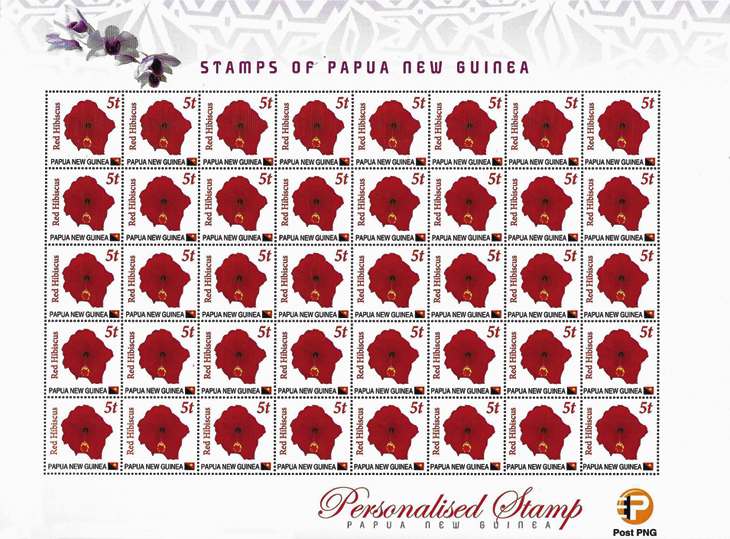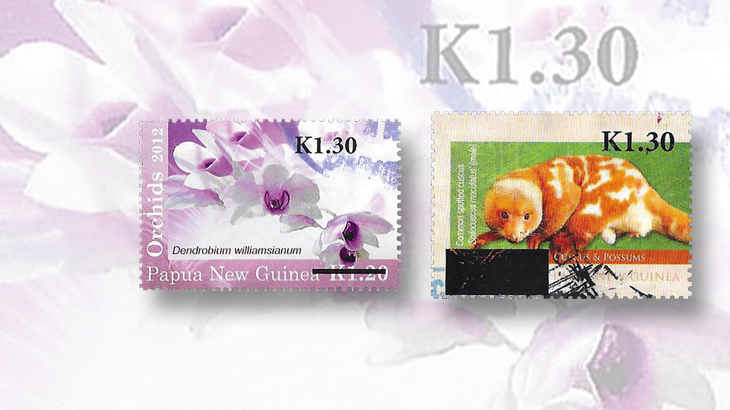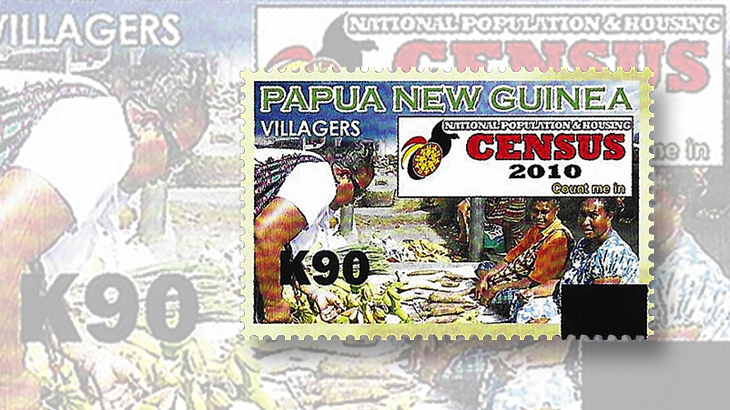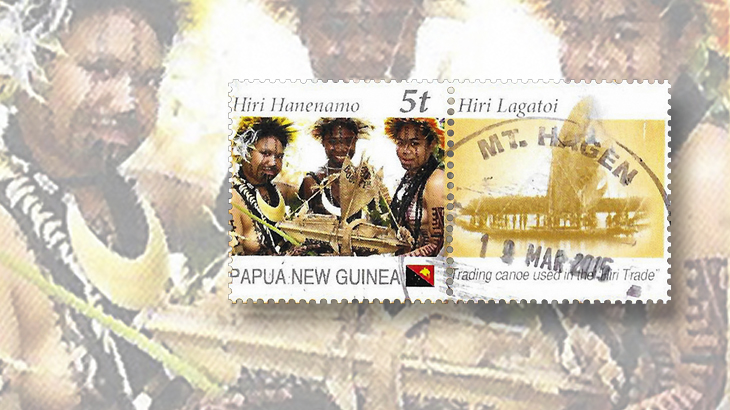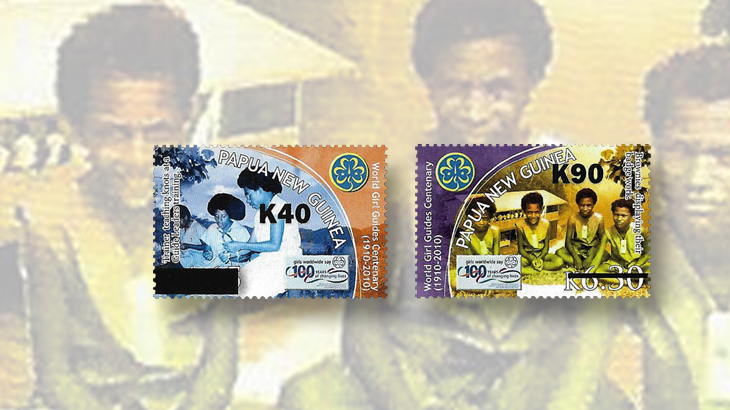World Stamps
Papua New Guinea surcharges appear in 2014-15 for new rates
By Steven Zirinsky
In early January 2014, Papua New Guinea’s Post PNG decided to increase the supply of its 1.30-kina local-rate postage stamps by revaluing obsolete 1.20k stamps.
While there were 5-toea and 10t stamps from previous issues, some post offices had already run out of these denominations due to previous increases, thus the decision to surcharge stamps.
After the stamps were revalued to the 1.30k denomination, they were sent to post offices that specifically requested them.
Eight stamps from 2012 were revalued: the Central Province and Madang Province stamps in the Cooking Pots set (Scott 1622-1623), the Common Gray Cuscus and Common Spotted Cuscus in the Marsupials issue (1628-1629), the commemorative honoring track and field athlete Iamo Launa (1634), the Dendrobium macrophyllum and Dendrobium williamsianium Orchid stamps (1640-1641) and the Telefonim Traditional Costumes stamp (1654).
On most of these stamps, a horizontal bar strikes out the initial denomination. However, a block obliteration was used on the Common Spotted Cuscus, Dendrobium macrophyllum Orchid and Telefonim Traditional Costumes stamps.
The surcharged stamps were issued in quantities of 1,250 each (50 sheets of 25). The earliest known uses are from August 2014.
Also in January 2014, Post PNG decided to act on the need for stamps with high denominations to pay the domestic and international rates to mail parcels.
Needed were 15k, 25k, 40k and 90k stamps.
The local rate for parcels weighing from 215 grams to 500 grams was 15k, which also paid the international rate for 51 grams to 150 grams.
The denominations of 25k, 40k and 90k were overseas rates for 151 grams to 250 grams, 251 grams to 500 grams and 501 grams to 1 kilogram, respectively. In addition, 25k was the local rate for 501 grams to 1 kilogram.
Various stamps were used, all with different initial denominations.
Surcharged with the new 15k denomination were the 2009 85t Black Bellied Bat (Scott 1395), the 2009 3.70k Beach Kalofilum (1358), and the 2011 1.05k Urban Safety and Crime Prevention (1557) stamps.
Three stamps of 2010 received new 40k denominations: the 6.30k Sea Cucumber (Scott 1440), and two Orchids stamps (1494-1495).
The 2009 6k Oil Palm Fruit Collection (Scott 1416) and 2010 4.65k Girl Guides Centenary (1451) stamps were surcharged to 40k.
The 6.30k Girl Guides Centenary stamp (Scott 1452) received a 90k surcharge, as did the 2010 3k Census (Scott 1460) and 2011 7k Siasi Traditional Dancers (1601).
All were printed in-house, and a block obliteration was favored for most of the overprints, except for three stamps that had a single thin bar crossing out the original denomination.
The 15k on 1.05k Urban Safety and Crime Prevention has a single diagonal line, the 90k on 6.30k Girl Guides Centenary has a horizontally line, and the 25k on 6.30k Sea Cucumber has them both.
Each of these 11 revalued stamps was produced in a quantity of 500 examples, 20 sheets of 25.
Distribution to post offices was by request. The first used examples appeared in May 2015.
At the beginning of 2015, the first-class local rate jumped from 1.30k to 1.35k, and the international rate increased from 6k to 6.20k.
This time, instead of overprinting stamps, the Post PNG issued 5t and 20t make-up rate stamps.
These stamps were printed with the same equipment that the Post PNG uses to create personalized stamps. The two different 20t stamps, one featuring Ahus dancers and the other showing Morobe dancers, were produced in sheets of 40.
Two different sheet sizes were used for the 5t stamps.
Initially, the 5t stamps were produced in sheets of 50, but when these ran out, the post office used a 40-stamp sheet to create more.
The stamps in sheets of 50 are larger and differently proportioned than those in sheets of 40, and the graphics are arranged differently as a result.
In addition, two 5t stamps were produced in sheets of 40 and in sheets of 20 with se-tenant labels. Again, the graphics were slightly different.
Six different 5t designs were printed in sheets of 50: Hiri Hanenamo, Aroma Students of Sogeri National High School, Red Hibiscus, Tokua Airport, Huli Dancers and Traditional Dancers. The quantity produced of each was 2,500 stamps, or 50 sheets.
The six 5t designs printed in sheets of 40 include the aforementioned Hiri Hanenamo, Aroma Students of Sogeri National High School, Red Hibiscus and Tokua Airport, plus Birdwing Butterfly and Hiri Lagatoi. The stamps were produced in a quantity of 2,000 stamps each, or 50 sheets of 40.
The two 5t sheets with labels, Hiri Hanenamo and Birdwing Butterfly, had 1,000 produced of each stamp, or 40 sheets.
The 20t stamps were produced in 50 sheet quantities totaling 2,000 stamps of each design.
All of these stamps were distributed on an as-needed basis to the post offices that requested them.
Also, as these stamps were produced in-house arising out of internal needs of the post office, no one thought to include the philatelic bureau in on the distribution, possibly because the quantities were so limited.
Steven Zirinsky, is a full-time architect and a part-time stamp dealer with an interest in modern commercial mail and postal affairs of a variety of countries. He can be contacted through his website.
MORE RELATED ARTICLES
Headlines
-
US Stamps
Oct 7, 2024, 3 PMMcMurtrie dismissed as APS education director following Sept. 21 arrest
-
US Stamps
Oct 7, 2024, 12 PMVasiliauskas named president of Mystic Stamp Co.
-
US Stamps
Oct 6, 2024, 5 PMApgar souvenir card available
-
US Stamps
Oct 6, 2024, 4 PMFirst Continental Congress and U.N. stamps receive Scott catalog numbers
